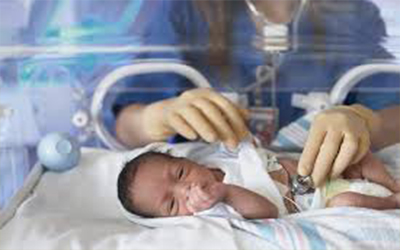It is very important to keep babies warm and identify problems early.
A baby begins to lose heat immediately after birth. Heat loss can be prevented by the following steps:
1. Baby should be dried immediately after birth and towels or clothing should be removed.
2. Baby should be placed between breasts.
3. Baby and mother should be covered with a clean, dry cloth or blanket. Baby’s head should be covered with a cap, and both hands and feet with socks.
4. Delivery room temperature should be maintained between 25℃/77℉ to 28℃/82.4℉.
Skin-to-skin care should begin at birth and should continue for at least two hours. During the first two hours, skin-to-skin care should be interrupted only for essential care, such as weighing, and should resume as soon as possible. Interruptions should be as brief as possible, and only areas necessary for care should be uncovered.
Rapid breathing after birth often occurs while normal lung fluid is being absorbed. Rapid breathing usually resolves by one or two hours after birth. However, rapid breathing that continues may be caused by a more serious problem that required advanced care. All babies should be monitored every 15 minutes for rapid breathing (>60 breaths/min) and chest in-drawing until the time of the first two hours after birth. This can be done by observation alone without handling if the baby appears normal.
Starting breastfeeding soon after birth helps mothers to provide enough milk later and establishes successful and exclusive breastfeeding. Early breastfeeding encourages bonding between mother and baby and it helps the uterus contract and reduces maternal bleeding. Breast milk, especially colostrum contains antibodies that protect babies against infection. It also provides nutrition, and is easily digestible.
Babies should receive only breast milk for the first 6 months (180 days). Babies who receive other food or liquids before six months of age are more likely to develop diarrhea, ARI and malnutrition. Counsel expectant mothers and family members about breastfeeding during antenatal visits and discuss it again before delivery.
care, such as weighing, and should resume as soon as possible. Interruptions should be as brief as possible, and only areas necessary for care should be uncovered.
Rapid breathing after birth often occurs while normal lung fluid is being absorbed. Rapid breathing usually resolves by one or two hours after birth. However, rapid breathing that continues may be caused by a more serious problem that required advanced care. All babies should be monitored every 15 minutes for rapid breathing (>60 breaths/min) and chest in-drawing until the time of the first two hours after birth. This can be done by observation alone without handling if the baby appears normal.To encourage early breastfeeding, mother and babies need to be kept together. Babies are often alert immediately after birth and will move towards the mother’s breasts but may not suck.
Provide Cord Care
Application of 7.1% Chlorhexidine on recently cut umbilical cord is a part of the essential newborn care package. It is a proven intervention to reduce newborn morbidity and mortality. Single application should be followed by dry cord care. No other antiseptic or other substance should be used after application of 7.1% Chlorhexidine.
Application of 7.1% Chlorhexidine on the newborn umbilical cord is application for all newborn irrespective of the place of delivery. If not applied immediately, it should be applied within 48 hours of birth.
Examine The Baby
Newborns will be examined within 90 minutes of birth to assess the wellbeing and detect any anomaly. The history and examination should include the following components:
Your content goes here. Edit or remove this text inline or in the module Content settings. You can also style every aspect of this content in the module Design settings and even apply custom CSS to this text in the module Advanced settings.
- Breathing should be checked every 15 minutes, noting especially chest in-drawing, grunting, and a slow or rapid rate of breathing after birth
- Temperature should be checked: hand, feet and abdomen should be felt for warmth if the baby feels cold to touch
- Feeding should be checked and breastfeeding should be observed
- Cord stump should be observed
- Skin color should be checked
- Activity and body movement should be checked
- Body weight should be measured
- Heart murmurs, jaundice and oral thrush should be checked
- The following areas should be checked for abnormalities in a systemic way: head, face, mouth and palate, chest, abdomen, genitalia, anus, limbs, back and skin
- Should be asked for frequency of passing urine and meconium
Criteria of a Normal Newborn:
- Respiratory Rate: 30-59 breaths/min
- Heart Rate: 100-160 beats/min
- Temperature: 36.5℃-37.5℃/97.5℉-99.5℉ (axillary, recorded over 3 minutes)
- Birth Weight: 2500 gm to 4000 gm
- Color: Pink but slight peripheral cyanosis for a few hours after birth
- Movement: Spontaneous, equal, arms and legs are flexed
- Cord Stump: No bleeding or drainage
- Feeding: Able to breastfeed soon after birth
- No apparent congenital malformation
- No birth trauma
- Passes meconium with 24 hours of birth
- Passes urine within 48 hours of birth

Baby’s temperature can be assessed reasonably by touching the abdomen, hand and feet with the dorsum of hand. In newborns, abdominal temperature is representative of the core temperature. When feet are cold and abdomen is warm, it indicated the baby is in cold stress. In hypothermia, both feet and abdomen are cold to touch.
A baby with normal temperature should have both body and feet warm to touch.
Axillary temperature is as good as rectal temperature but much safer, and is measured for 3 minutes.

All babies should be weighted within 90 minutes of birth. Birth weight classifies and identifies babies who may need special care, provides a baseline for monitoring growth and necessary for calculating doses of fluids and drugs.
Identify babies at risk:
- Below 2500 gm, babies require special care for feeding and appropriate thermal care to prevent loss of body temperature.
- Below 2500 gm, babies (of baby is stable) should receive Kangaroo Mother Care (KMC) to ensure feeding, thermal care, and infection prevention. KMC should be initiated in the hospital.
- If the baby is having extreme low birth weight that is <1200gm, babies should reveive advanced care (e.g. gavage feedings or intravenous fluids) and when the baby becomes stable, Kangaroo Mother Care should be initiated.
By 90 minutes following birth, babies should be classified as normal, having a problem or having danger sign.
Classification is based on the baby’s weight, feeding, temperature and examination.
Some babies breathe fast soon after birth but improve gradually over the next 3-4 hours. They should not be classified as having a danger sign and there is no need for advanced care if this situation improves continuously but they need to be monitored closely.
Some babies do not attach to the breast during the first 90 minutes after birth and therefore do not feed. If these babies are normal in all other ways, feeding should be attempted again. Babies who do not feed after several attempts should be classified as having a danger sign.



Continue Support For Breastfeeding
A baby, who is ready to breastfeed looks around, opens the mouth, with the head straight back with tongue down and forward and licks. The baby should be placed in a position to breastfeed when these signs appear.Mother can breastfeed at her comfortable position (either sitting or lying down) and should not bend towards the baby. Baby’s body should be straight; head and shoulder must be in one line, baby should be close to the mother and baby’s whole body should be supported (especially buttock) by mother’s hand.Baby should be fed on demand, usually 2-3 hours (8-12 times) a day including night time feeds. Baby getting enough milk is satisfied between feeds, sleeps well, passes urine at least 6-8 times per 24 hours, and gains average weight 20-40 gm per day.
Start Immunization
Immunization with BCG and OPV can be started soon after birth and all immunizations should be completed by the age of 15 months.
In case of immunization:
⦁ Sick newborn should not be immunized
⦁ Sick newborn should not be immunized
⦁ Nothing should be applied to BCG scar
⦁ If mother is HIV positive, vaccines are often deferred until the baby is known to be HIV positive.
⦁ If any serious adverse events had occurred in previous dose of vaccination, in case of next dose, advice from physician should be taken.
During vaccination:
⦁ AD syringe nest be used
⦁ AD syringe nest be used
⦁ All sharps need to be disposed of in the safety box
⦁ Mother should be counselled about side effects and completion of remaining vaccines
⦁ Mother should be encouraged for breastfeeding



